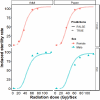Evaluating the biological quality of mass-reared Anopheles arabiensis males irradiated as pupae or as adults
- PMID: 40598502
- PMCID: PMC12220225
- DOI: 10.1186/s12936-025-05455-x
Evaluating the biological quality of mass-reared Anopheles arabiensis males irradiated as pupae or as adults
Abstract
Background: The success of a sterile insect technique programme to control target mosquito populations depends on producing high-quality sterile males that can compete with wild males to inseminate wild females, to consequently inhibit procreation. To succeed, the released males require high biological quality. The quality of laboratory-reared, sterile males can be affected by the rearing conditions, handling, transportation, and irradiation. Limiting the cumulative damage caused by all these processes is key to maintain sterile male performance in the field once released. The ideal life stage to irradiate Anopheles arabiensis males is still an important question for this species. This study aims to assess the dose response of irradiated males at pupal versus adult stages and use quality control (QC) parameters to assess the feasibility and possible advantages of shifting to adult irradiation in this species.
Methods: Laboratory reared An. arabiensis males were irradiated as late-stage pupae or as adults at varying doses to compare the radiosensitivity in both developmental stages. Males irradiated at fully sterilizing doses were further subjected to quality control tests to compare the quality of males irradiated at adult versus pupae stages. The QC parameters tested included flight ability, longevity and mating competitiveness.
Results: The results show that adults do not require more radiation dose to achieve the target sterility, and females are more radiosensitive than males. Longevity, flight ability and mating competitiveness were improved significantly in males irradiated as adults compared to that of males irradiated as pupae.
Conclusions: Given the challenges in synchronizing pupation in a mass rearing setting and achieving a homogenous age (i.e. late-stage pupae) of collected pupae in this species, as well as these findings on the overall improvement of sterile male quality in the males irradiated as adults, this report provides a strong argument for irradiation protocols to shift towards adult stage irradiation in SIT programmes against An. arabiensis.
Keywords: Fitness; Life stage; Malaria vector; Quality control; Sterile insect technique.
© 2025. The Author(s).
Conflict of interest statement
Declarations. Competing interests: The authors declare no competing interests.
Figures




Similar articles
-
Larvivorous fish for preventing malaria transmission.Cochrane Database Syst Rev. 2017 Dec 11;12(12):CD008090. doi: 10.1002/14651858.CD008090.pub3. Cochrane Database Syst Rev. 2017. PMID: 29226959 Free PMC article.
-
Optimizing irradiation dose for Drosophila melanogaster males to enhance heterospecific Sterile Insect Technique (h-SIT) against Drosophila suzukii.PLoS One. 2025 Jul 3;20(7):e0320546. doi: 10.1371/journal.pone.0320546. eCollection 2025. PLoS One. 2025. PMID: 40608745 Free PMC article.
-
Impact of irradiation on the reproductive traits of field and laboratory An. arabiensis mosquitoes.Parasit Vectors. 2018 Dec 17;11(1):641. doi: 10.1186/s13071-018-3228-3. Parasit Vectors. 2018. PMID: 30558681 Free PMC article.
-
Systemic pharmacological treatments for chronic plaque psoriasis: a network meta-analysis.Cochrane Database Syst Rev. 2021 Apr 19;4(4):CD011535. doi: 10.1002/14651858.CD011535.pub4. Cochrane Database Syst Rev. 2021. Update in: Cochrane Database Syst Rev. 2022 May 23;5:CD011535. doi: 10.1002/14651858.CD011535.pub5. PMID: 33871055 Free PMC article. Updated.
-
Systemic pharmacological treatments for chronic plaque psoriasis: a network meta-analysis.Cochrane Database Syst Rev. 2017 Dec 22;12(12):CD011535. doi: 10.1002/14651858.CD011535.pub2. Cochrane Database Syst Rev. 2017. Update in: Cochrane Database Syst Rev. 2020 Jan 9;1:CD011535. doi: 10.1002/14651858.CD011535.pub3. PMID: 29271481 Free PMC article. Updated.
References
-
- WHO. Global technical strategy for malaria. Geneva, World Health Organization. who int/media/docs/default-source/malaria/gts/who-global-technicalstrategy-for-malaria-update-4apr2021 pdf. 2021;
-
- Oliva CF, Vreysen MJB, Dupé S, Lees RS, Gilles JRL, Gouagna L-C, et al. Current status and future challenges for controlling malaria with the sterile insect technique: technical and social perspectives. Acta Trop. 2014;132S:S130–9. - PubMed
MeSH terms
LinkOut - more resources
Full Text Sources

